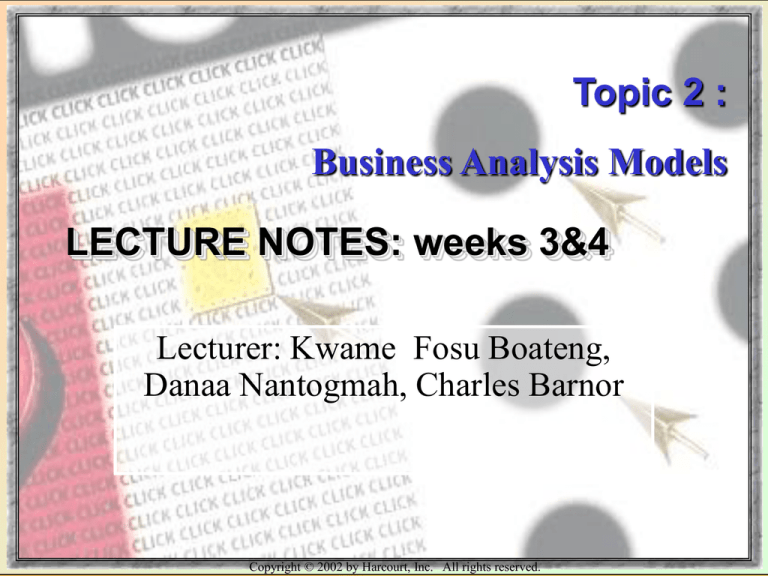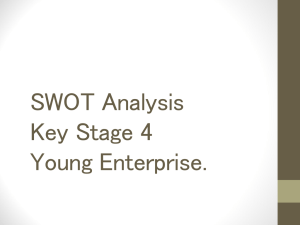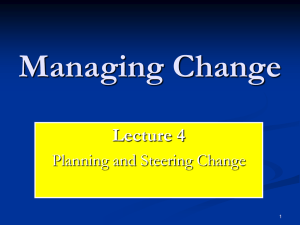
Topic 2 :
Business Analysis Models
LECTURE NOTES: weeks 3&4
Lecturer: Kwame Fosu Boateng,
Danaa Nantogmah, Charles Barnor
Copyright © 2002 by Harcourt, Inc. All rights reserved.
LEARNING GOALS
1.
2.
3.
4.
5.
6.
Key learning goals:
This topic will introduce two well-known business analysis
models, SWOT and PESTEL, which are commonly used
as tools to analyze and develop business strategies.
Define what strategy is
Discuss the three level of strategy
Identify and describe at least ten different corporate level,
business level, functional strategies
State the 4 areas of SWOT analysis and tell which are
internal and which are external by giving some examples.
State the 4 areas of PESTEL analysis and give at least
some examples for each.
Do a case study.
Copyright © 2002 by Harcourt, Inc. All rights reserved.
•
•
•
What is a strategy
Levels of strategy
Types of strategies
• Forward Integration
• Backward Integration
• Horizontal integration
• Market penetration
• Market development
• Product development
• Diversification(related and unrelated)
• Liquidation
• Retrenchment
• Divestiture
Copyright © 2002 by Harcourt, Inc. All rights reserved.
Forward Integration
Gaining ownership or increased control over distributor or
retailor
Alternative Seeking
Strategies
ownership or increased control of a firms suppliers
Backward Integration
Horizontal integration
Seeking ownership or increased control over competitors
Market Penetration
Seeking to increase market share for present products or services
in present markets through greater marketing efforts
Market Development
Introducing present products or services to a new geographic area
Product Development
Seeking to increased sales by improving existing product or
service or developing a new product.
Related Diversification
Adding new but related products or services
Unrelated Diversification
Adding new unrelated products or services
Retrenchments
Regrouping through cost and assets reduction to reverse declining
sales and product
Divestiture
Selling a division or part of an organization
Liquidation
Selling all a company’s assets, in parts, for their tangible worth
Copyright © 2002 by Harcourt, Inc. All rights reserved.
A strategy of an organisation is a
comprehensive master plan stating how
corporation will achieve its mission and its
objectives. It maximizes competitive advantage
and minimizes competitive disadvantage. The
typical business firm usually considers three
types of strategy: corporate, business and
functional
Copyright © 2002 by Harcourt, Inc. All rights reserved.
The Strategy-Making Pyramid for
Diversified Enterprises
Corporate
Strategy
• Corporate Level Managers
Business
Strategies
Functional
Strategies
Operating Strategies
• Business Level General Managers
• Heads of major Functional Areas
• Plant managers
• Lower Level Supervisors
Copyright © 2002 by Harcourt, Inc. All rights reserved.
Corporate-Level Strategy
• Corporate-Level Strategy is concerned with the overall purpose and
scope of an organisation and how to add value to business units.
•
• Corporate strategies are the overall game plan for a diversified
•
•
company and it consists of
moves to establish business positions in different industries
approaches to managing group of businesses the enterprise has
diversified into.
•
• To succeed corporate strategies should add value to the corporation.
To add value, a corporate strategy should enable a company or more of
its business units to perform one or more of the value creation
activities at a lower cost, or perform one or more of the value creation
activities in a way that allows for differentiation and premium price
Copyright © 2002 by Harcourt, Inc. All rights reserved.
Business level strategy- Competitive
Strategy
•
•
•
•
•
•
•
Business-Level Strategy is concerned with the way a business seeks to
compete successfully in its particular market. Issues involve pricing,
innovation or differentiation strategy.
It therefore involves
Forming responses to changes in the industry, economy, regulatory and
political arena
Crafting competitive moves that lead to sustainable competitive advantage
Uniting strategic initiatives of functional areas (Manufacturing, Marketing,
HR, R&D, Finance, etc).
Addressing strategic issues related to the firm’s competitive position and
internal situation.
Whereas corporate-level strategy involves decisions about the organization as
a whole, strategic decisions relate to particular strategic business units within
the overall organization. A strategic business unit (SBU) is a part of an
organization for which there is a distinct external market for goods or services
that is different from another SBU
Copyright © 2002 by Harcourt, Inc. All rights reserved.
Functional Strategies
•
Functional strategies are the game plan for running a
particular function within a business. It adds detail to
business strategy and governs how key activities will be
managed. A business needs as many functional strategies
as it has major functional activities.
•
• The role of functional strategies is to
• Provide support for overall business strategy
• Specify how functional managers plan to achieve
functional area performance objectives
Copyright © 2002 by Harcourt, Inc. All rights reserved.
•
Operational Strategies – how
component parts of the
organization
Operational Level Strategy is concerned with how
different parts of the organisation deliver the strategy in
terms of managing resources, processes and people.
• Operational Strategies concerns even narrower strategic
approaches for managing key operational units. It is
designed to achieve strategy-critical performance targets of
operating-level units and adds detail to overall business
plan and functional strategies but are of lesser scope. Eg.
Plant or Product line
Copyright © 2002 by Harcourt, Inc. All rights reserved.
EXTERNAL ENVIRONMENTAL
ANALYSIS
•
•
•
The external environment consists of all elements
outside the domain of an organization which
has/can have an influence of the competitive
position of an organization
The essence of conducting an external
environmental analysis/audit is to develop a finite
list of opportunities that could be of benefit and
threats that should be avoided
Thus it is not aimed at developing an exhaustive
list of every factor that could influence a business
rather it is aimed at identifying key variables that
offer actionable responses (offensive or
defensive) in strategy formulation.
Copyright © 2002 by Harcourt, Inc. All rights reserved.
Components of the External Environment
The organization
The industry
(Immediate external
environment)
The remote external
Environment
Copyright © 2002 by Harcourt, Inc. All rights reserved.
Tools for conducting External
Environmental Analysis
• Immediate External Environment (Industry)
• To conduct analysis in this environment, the
Porters Five Forces is used
• The Remote External Environment
• To conduct analysis in this environment the
PESTEL is used.
Copyright © 2002 by Harcourt, Inc. All rights reserved.
PORTERS FIVE FORCES
[INDUSTRY ANALYSIS]
Potential
development
of
substitutes
Bargaining
Power of
suppliers
Rivalry
among
competing
firms
Potential
entry of new
competitors
Copyright © 2002 by Harcourt, Inc. All rights reserved.
Bargaining
power of
Consumers
Porters
Five
Forces
cont’d
• Industry competitors: Rivalry among existing competitors takes many
familiar forms, including price discounting, new product introductions,
advertising campaigns, and service improvements. High rivalry limits the
profitability of an industry. The degree to which rivalry drives down an
industry's profit potential depends, first, on the intensity with which
companies compete and, second, on the basis on which they compete.
• New Entrants: New entrants to an industry bring new capacity and a
desire to gain market share that puts pressure on prices, costs, and the rate
of investment necessary to compete. Particularly when new entrants are
diversifying from other markets, they can leverage existing capabilities and
cash flows to shake up competition, as Pepsi did when it entered the bottled
water industry, Microsoft did when it began to offer internet browsers.
• Substitute: A substitute performs the same or a similar function as an
industry's product by a different means. Videoconferencing is a substitute
for travel. Plastic is a substitute for aluminium. E-mail is a substitute for
express mail. When the threat of substitutes is high, industry profitability
suffers. Substitute products or services limit an industry's profit potential by
placing a ceiling on prices. If an industry does not distance itself from
substitutes through product performance, marketing, or other means, it will
suffer in terms of profitability - and often growth potential.
Copyright © 2002 by Harcourt, Inc. All rights reserved.
•
•
Porters Five Forces cont’d
Buyers: Powerful customers - the flip side of powerful suppliers
can capture more value by forcing down prices, demanding better
quality or more service (thereby driving up costs), and generally
playing industry participants off against one another, all at the
expense of industry profitability. Buyers are powerful if they have
negotiating leverage relative to industry participants, especially if
they are price sensitive, using their clout primarily to pressure price
reductions.
Suppliers: Powerful suppliers capture more of the value for
themselves by charging higher prices, limiting quality or services, or
shifting costs to industry participants. Powerful suppliers, including
suppliers of labour, can squeeze profitability out of an industry that
is unable to pass on cost increases in its own prices. Microsoft, for
instance, has contributed to the erosion of profitability among
personal computer makers by raising prices on operating systems.
PC makers, competing fiercely for customers who can easily switch
among them, have limited freedom to raise their prices accordingly.
Copyright © 2002 by Harcourt, Inc. All rights reserved.
Business Analysis Models
-PEST Analysis
What is PEST analysis?
• PEST analysis is an analysis model examining
•
•
the external environment and the global factors
that may affect a business.
It can provide a quick understanding of the
external pressures facing a business and their
possible constraints on its strategy.
It is usually divided into four external influences
on a business – political, economic, social and
technological.
Copyright © 2002 by Harcourt, Inc. All rights reserved.
Business Analysis Models
-Illustrations for PEST Analysis Models
Political
1.
2.
3.
4.
Purposes:
To find how political development,
locally, nationally, internationally
affect the strategy of a business.
Areas to be considered:
Consumer laws and regulation
Political pressures,
Government views of certain
business activities, including local,
national or international
government political issues
affecting a business
…
© PhotoDisc
Copyright © 2002 by Harcourt, Inc. All rights reserved.
Business Analysis Models
-Illustrations for PEST Analysis Models
Purposes:
Political
Economic
1.
2.
3.
4.
© PhotoDisc
To find how economic factors may
affect on the business.
Areas to be considered:
Consumer activities, such as
spending patterns
Economic conditions, such as
inflation, unemployment, growth,
etc.
Government policies, such as fiscal,
monetary, exchange rates, etc.
The changes in production and labor
market …
Copyright © 2002 by Harcourt, Inc. All rights reserved.
Business Analysis Models
-Illustrations for PEST Analysis Models
Political
Economic
1.
2.
Social
3.
4.
© PhotoDisc
Purposes:
To find what competitive advantage a
business may gain by social changes.
Areas to be considered:
Aging population trend, which may increase
services for old people
Birth rate increase, which may affect baby
product markets
Security condition, e.g. increase in crime
may cause a business to increase insurance
costs
Pressure groups, such as environmental
groups, local community groups, etc. which
may prevent a business from polluting a
river…
Copyright © 2002 by Harcourt, Inc. All rights reserved.
Business Analysis Models
-Illustrations for PEST Analysis Models
Purposes:
To find how new technologies
might affect the business
activities.
Areas to be considered:
1. The rate of technological change
2. The development of IT
3. The wide use of Internet
4. The creation of new materials for
Political
Economic
Social
Technological
production …
Impacts:
All these technological changes will
lead to some effects on the business,
such as the product of the business may
be replaced by new products or its
production methods may have become
out of date.
© PhotoDisc
Copyright © 2002 by Harcourt, Inc. All rights reserved.
Business Analysis Models
-SWOT and PEST
Question for your critical thinking:
Please try to tell what the key difference is
between SWOT and PEST models.
Copyright © 2002 by Harcourt, Inc. All rights reserved.
PESTEL
[Remote Environmental Analysis]
•
PESTEL stands for Political, Economic, Socio-cultural,
Technological, Environmental, (or ecological and Legal
•
Political: Political factors include change in governments may be
limited to home country but other , international bodies such as
ECOWAS, and EU with corresponding changes in policies and
priorities may have an impact the organization and how it operates.
•
Economic: Economic factors may also be limited to the home
country, but as global trade continues to grow, economic difficulties
in one nation tend to have broader impact. For instance the 2008
financial crisis was as a result of USA mortgage crisis but it ended
up affecting many nations including Ghana.
•
Socio-cultural: These are factors that arise as a result of
demographic change or changes in consumer behaviour patterns,
cultural norms and even religious considerations
Copyright © 2002 by Harcourt, Inc. All rights reserved.
PESTEL
Cont’d
• Technological: this is a result of the development of technology. There are
two types of technological change, which are developments in IT and
developments in technology specific to an industry or market. The
identification of technology that provide opportunity for the growth of the
organization is very critical if an organization is able to recognize the
potential that earlier.
• Legal: It is vital to consider factors arising from changes to the law. Some
legal issues may originate from the national government but others, may
operate across a broader spectrum. One issue when considering the legal
element of the PESTLE analysis is to recognise laws that have an impact
upon the organization even though the originated from countries other than
that in which the organization is based. Recent examples are the changes to
international financial compliance regulations, such as the Sarbanes -Oxley
Act in the USA and the Basel II Accord.
• Environmental (or ecological): Is about the concerns with regard to the
'green issues'. There are increasing concerns about packaging and the
increase of pollution.
Copyright © 2002 by Harcourt, Inc. All rights reserved.
Business Analysis Models
-SWOT Analysis
What is SWOT analysis?
• SWOT analysis involves looking at the internal
•
•
strengths and weaknesses of a business and external
opportunities and threats.
In other word, it is used to analyze the possible internal
advantages and problems that a business has, and to
determines the external factors of the business which
may affect its strategy.
The purpose of a SWOT analysis is to conduct a
general and quick examination of a business’s current
position so that it can help the business to develop or
plan a direction of development or a proper strategy in
future.
Copyright © 2002 by Harcourt, Inc. All rights reserved.
Figure 6-1 Elements of SWOT Analysis
Copyright © 2002 by Harcourt, Inc. All rights reserved.
Business Analysis Models
-SWOT Analysis
Uses of SWOT analysis:
SWOT analysis is an effective way of gathering and
classifying information, illustrating particular matters,
and generating strategic planning ideas for a business.
The result of the analysis may provide a basis on which
a more detailed analysis can be conducted.
SWOT analysis is, therefore, often used as a method by
which a business or its marketing department can plan
its marketing strategy. Some examples of SWOT
analysis are given in the following table:
Copyright © 2002 by Harcourt, Inc. All rights reserved.
Business Analysis Models
-Examples or Illustrations for SWOT
Analysis Models
Strengths
• Good brand image
• Well-known name
• Good reputation
• Cost advantage in production
• High market share
• Confidence in the market
• Customer loyalty or repeat
•
•
business
More advanced technology
and R & D
…
© PhotoDisc
Copyright © 2002 by Harcourt, Inc. All rights reserved.
Business Analysis Models
-Examples or Illustrations for SWOT
Analysis Models
•
•
•
•
Strengths
Weaknesses
•
•
•
•
•
© PhotoDisc
•
Ineffective in production
Falling profit
Falling sales of the product
Declining age of the life cycle of a
product
Poor reputation
Lack of innovation and change
Lack of adequate capital or having
some financial problems
Customers’ losing confidence or
increasing complaints on the business
Poor management or inefficient
organizational structure
….
Copyright © 2002 by Harcourt, Inc. All rights reserved.
Business Analysis Models
-Examples or Illustrations for SWOT
Analysis Models
Strengths
Weaknesses
•
•
•
•
•
Opportunities
© PhotoDisc
•
•
•
Possible development of new
products
Expansion into new markets
Development of a global brand
Joint –development with other
companies
Possible growing demand for a
product in the market
Possible government policies
encouraging the growth of the
business and its certain products
New sources of profit or income
….
Copyright © 2002 by Harcourt, Inc. All rights reserved.
Business Analysis Models
-Examples or Illustrations for SWOT
Analysis Models
• Changes in law or regulation
Strengths
•
Weaknesses
•
•
Opportunities
•
Threats
•
which may prohibit or affect the
production of a business
Growing competition from local
companies
Increasing competition from
foreign competitors
New products developed by
other companies which may
replace the product of the
business
Marketing activities or strategies
which will be implemented by
competitors
…..
© PhotoDisc
Copyright © 2002 by Harcourt, Inc. All rights reserved.
Business Analysis Models
-SWOT Analysis
Question for your critical thinking:
Please briefly make a SWOT analysis on
yourself based on the analysis model we have
discussed in the class within 10 minutes.
Copyright © 2002 by Harcourt, Inc. All rights reserved.












